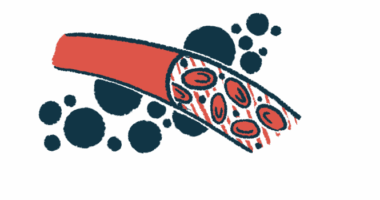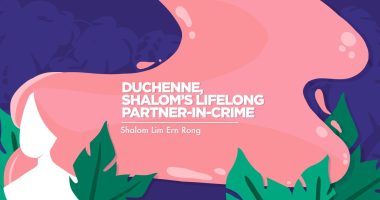Being active with DMD: Physical therapy and exercise
Last updated June 17, 2024, by Susie Strachan

Physical therapy is an important part of a Duchenne muscular dystrophy (DMD) treatment plan. It helps maintain flexibility, range of motion, and muscle strength, while also addressing changes in mobility.
A physical therapist knowledgeable about DMD and progressive muscle weakness and other DMD symptoms can create a therapeutic exercise program that safely stretches and strengthens the body. They also can show you how to use assistive devices such as mobility aids and orthotic devices.
Benefits of physical therapy for people with DMD
DMD physical therapy plays a key role in treatment throughout all stages of life, whether supporting a young child who is still running around, a teenager with reduced mobility, or an adult using mobility aids.
DMD is caused by mutations in the DMD gene. The gene is located on the X chromosome, which is one of the two sex-determining chromosomes. Men have one X chromosome while women have two, which is why the disease is more common in men.
DMD causes a weakening of the muscles and flexibility. It typically starts by affecting proximal muscles — those close to the body’s trunk, including the shoulders and upper arm muscles, as well as the muscles on the hips and thighs. It later progresses to the distal limb muscles — the ones closer to the extremities, such as the feet and hands.
At first, the disease may interfere with walking and climbing stairs. But it progresses, making sitting, standing, and maintaining posture challenging.
A physical therapist (also known as a physiotherapist) will choose exercises suitable for the stage of progression, such as strengthening arm and leg muscles, stretching muscles and tendons, and treating contractures. Contractures are caused by a shortening of muscles or tendons, affecting range of motion of joints.
Physical therapist Jennifer Wallace has been working with boys, teens, and adult men living with DMD since 2002 at her private practice Duchenne Therapy Network south of Los Angeles. She is also an outreach trainer with CureDuchenne.
Wallace says the goal of physical therapy (PT) as a DMD treatment is to preserve function. It also can teach you how not to overdo physical activities, which can potentially damage muscles.
“What the Duchenne historical data shows us, we may not make anyone better,” Wallace says. “But we are trying to help them maintain what they have for as long as possible and to deter some of that progression that we know is coming.”
Generally, physiotherapy can help a person with DMD:
- maintain abilities such as mobility, grasping objects, or getting up from a chair, for as long as possible
- stretch shortened muscles, which can cause contractures
- avoid movements that can damage muscles
- learn how to use orthotic devices properly, such as wearing resting foot-ankle orthoses at night to help with ankle stiffness.
Physical evaluation
Instead of relying on age as an indicator of disease progression, a physical therapist should do an assessment and build a physical therapy program based on your abilities.
“In the younger stages of Duchenne, young boys may appear mostly normal. They’re running, they’re playing, they’re being kids,” Wallace says. “But I would say, to a keen eye, you can spot clinical signs from when they begin to walk. However, they’re still active and they’re still motivated by play.”
She works with a child’s family on modifying activities to help preserve muscle strength and conserve energy so the child can play safely.
When muscle loss reaches what Wallace calls the “middle stage,” there is likely to be a plateau in a child’s ability to gain new physical skills.
“We have to work hard at this stage,” she says. “Because while they’re not gaining ability, they’re not losing it either.”
This is followed by the late ambulatory or transition stage, where teenagers and young adults begin to lose function.
Wallace observes how someone in this stage can handle balancing, which muscles are being used most, and which joints are getting in the way of better functional movement.
“Perhaps they start tripping and falling more often, or can’t get up out of a chair or off the floor,” Wallace says. “These things happen before they lose the ability to walk.”
Personal therapy plan
After an evaluation, a physical therapist will adapt treatment to help you move better and maintain muscle strength and flexibility with exercises that are suitable for your stage of disease progression.
“We need to be proactive in Duchenne, to keep people mobile as long as possible, not only to delay disease progression, but because of the drugs in the development pipeline,” Wallace says.
She points out that when people are in better physical condition, they may benefit more from medications and other DMD treatments.
Suitable exercises for DMD
Wallace warns that treating someone with Duchenne without properly understanding the disease puts them at risk for further muscle damage and function loss.
“With Duchenne, we have to be extremely careful about causing muscle damage with the choices we make in treatments,” Wallace says.
While puberty may be delayed for a boy with DMD due to the medications they are taking, it often happens at the same time they are beginning to lose muscle function.
“If you have joint and muscle stiffness already, and then you grow all of a sudden, those muscles are still really stiff and want to stay short,” she says. “But your bones want to grow, so it can make the joint contractures even worse.”
Brittle bones (osteoporosis caused by the loss of bone density) is another condition associated with DMD. Osteoporosis may lead to bones that are easily broken, especially in the legs.
Exercises suitable for someone with DMD focus on:
- level of progression in muscle weakness
- level of flexibility
- safety during exercise.
Strengthening exercises
Physical therapy can help with strengthening and maintaining the muscles of the upper and lower extremities by working on:
- quadriceps, hamstrings, calves, shoulders, arms, and hands
- postural alignment, addressing spinal curvature (scoliosis), and optimal sitting and standing posture to prevent discomfort.
While a person with DMD should avoid muscle-damaging exercises such as lifting weights, using resistance bands, or playing most sports, they can do gentler activities that help maintain muscle, such as:
- walking in a swimming pool
- using an exercise bike or a power assisted exercise bike.
Wallace recommends walking in a pool because of the light resistance. She also suggests doing physical activity that uses your own body weight for strengthening, such as lifting arms to the front, side and over your head, which helps maintain arm and shoulder strength.
Stretching exercises
The goal of stretching exercises for someone with DMD is to stretch tight or shortened muscles, and tendons to treat contractures and joint stiffness.
Along with teaching stretching exercises for doing at home, a physical therapist might use:
- foam rollers, to apply pressure to muscles and soft tissues, which can help reduce tension
- exercise balls, to provide support and stability while allowing you to use multiple muscle groups
- stretching straps, to gently guide and support your limbs while doing stretches
- a pulley system, to help move limbs through a controlled range of motion.
Stretching at home
Your physical therapist can teach you self-stretching techniques to do daily at home to help maintain flexibility and independence.
Examples of stretches you may be shown for doing at home by yourself or with the help of a caregiver are:
- trunk rotations, where you lie on your back with knees bent
- Achilles tendon stretches
- finger and wrist extensions, done while seated.
It can be helpful to take a warm bath or shower before stretching, and to warm up the muscles with a gentle massage from a caregiver.
Stretching exercises shouldn’t hurt. If you experience pain, stop doing the exercise and contact your physical therapist.
Using assistive devices
A physical therapist can help you learn how to use mobility devices, such as a manual or power wheelchair or scooter, along with other assistive devices.
The goal of assistive technology is to improve quality of life. Some devices may require training, such as sip-and-puff switches, which read your signals — sip (inhale) or puff (exhale) — and convert it to on-off signals, which can be used to control a power wheelchair.
“There are all kinds of alternative controls, so if you don’t have good use of your hand, you can steer with your chin or your nose or the side of your head,” Wallace says.
Robotics, such as a robotic arm that is attached to a power wheelchair to help lift and carry items, is a fairly new field that Wallace has been exploring with her DMD patients.
The role of parents and caregivers
Parents and caregivers often are a supporting part of physical therapy. Caregivers may attend physical therapy sessions to learn how to lead stretching sessions.
“There’s a lot of training that goes on in a physical therapy session in a clinic, so people continue to do this at home,” Wallace says.
She was instrumental in designing CureDuchenne’s certification program for physical therapists to improve the standard of care for DMD patients in the U.S.
“The PTs who take the course have to maintain their certification from year to year,” she says. “And we ensure they stay up to date on the best practices for working with people with Duchenne.”
Parents and caregivers also have access to CureDuchenne’s physical therapy education online modules.
Muscular Dystrophy News is strictly a news and information website about the disease. It does not provide medical advice, diagnosis, or treatment. This content is not intended to be a substitute for professional medical advice, diagnosis, or treatment. Always seek the advice of your physician or other qualified health provider with any questions you may have regarding a medical condition. Never disregard professional medical advice or delay in seeking it because of something you have read on this website.
Related articles






